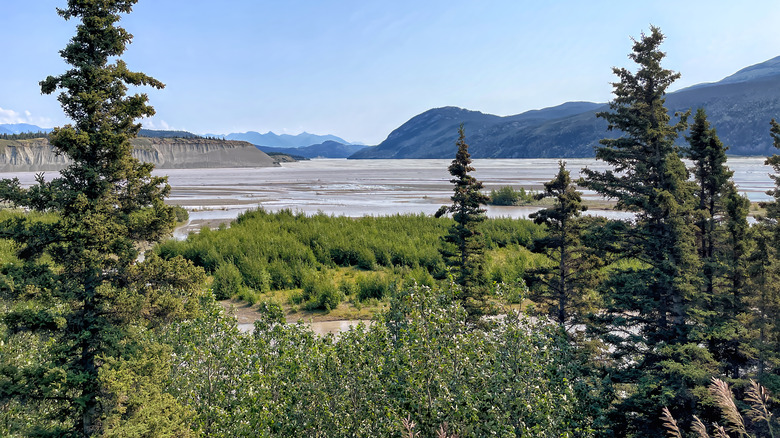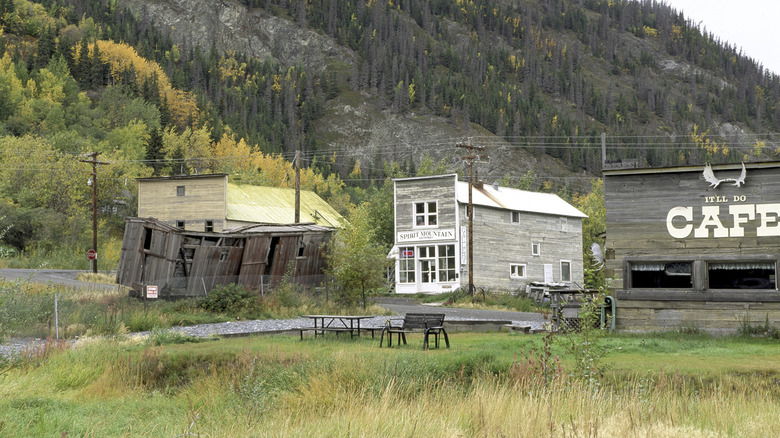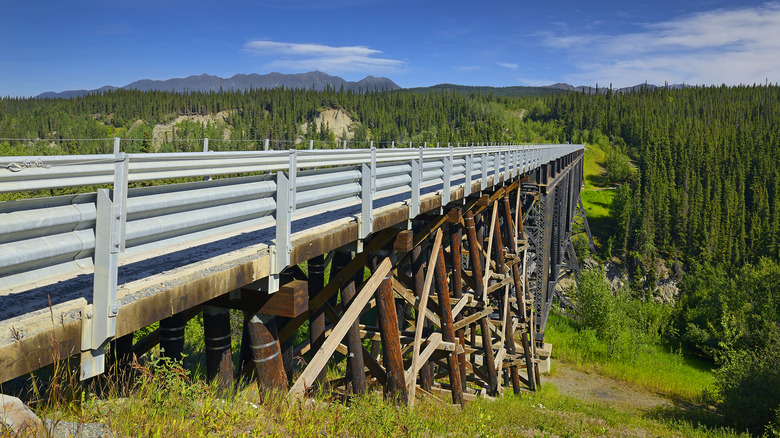This Overlooked Town Is A Perfect Gateway To The Largest National Park In America
Trivia question: What is the largest national park in America? No cheating. Here's a hint — it's not within the contiguous U.S., but within the continental U.S. If you've figured out it's in Alaska, you'll understand why it's so vast. This is the land of dynamic landscapes like the remote and beautiful Adak Island and rarely visited gems like Lake Clark National Park. Beyond the seemingly endless mountains, glaciers, and waterways sits Wrangell-St. Elias National Park, which covers a vast 13.2 million acres.
Even with all the adventure-packed opportunities Wrangell-St. Elias provides across this large swatch of the southeastern portion of the 49th state, there are only two primary entrances to the park. The first is Nabesna Road on the north, which is historically rich yet very primitive. The second option is only slightly more developed: the road that leads from the town of Chitina (Chit-Na). Despite the village of around 100 people serving as the gateway to the largest protected park and preserve in our nation, it's barely a pencil dot on a map. However, this landmark should not be overlooked because it has much to offer in its own right.
History and charm in Chitina, Alaska
While Wrangell-St. Elias National Park presents rugged landscapes in every direction, Chitina offers a more accessible connection with nature, history, and charisma. That's because it has been through several transitions. In the early 1900s, it drew attention as a thoroughfare for shipping the products from the Kennecott Mine 60 miles up the road. Then, it blossomed with the designation of a railroad station. During the golden era of railroad development and mining, it became a thriving community of around 3,000 people. However, when the mine pulled stakes, Chitina transformed into a ghost town.
For years, it remained a small community, mostly made up of generations of Athabascan peoples — natives who lived off the land. However, when Wrangell-St. Elias National Park was established in 1980, Chitina once again found itself on the map, this time as the gateway to the massive piece of public land to the east. While it may serve a purpose for tourists, it's still primarily a local outpost for fishermen who flock to the area for the seasonal salmon fishing along the Copper River.
Even as most fishermen pass through for the day, visitors can stay to explore the historic buildings and quaint B&Bs that make up the quiet streets. They can take in some sport fishing or head 15 minutes up the highway to Liberty Falls. Chitina is also the best spot to gather information about the region, with a stop at the ranger station.
What to do near Chitina
In addition to the draws of the wild and rugged Wrangell-St. Elias National Park, a visit to Chitina demands exploration of its natural wonders. Located near the meeting point for the Copper River and the Chitina River, it's hard not to appreciate the power of the waters there. Perhaps that majestic statement is only dwarfed by the shadow of the over 16,000-foot-high Mount Blackburn that overlooks the town.
Although Chitina has its undeniably quaint charms, most people stop on their way to nearby camping or backpack in the wilderness. When you're ready for a real adventure, make sure you have a spare tire and a satellite phone before heading for the even more rustic towns of McCarthy and Kennecott. Although only 60 miles up a seasonally-maintained road, expect it to take two to three hours. Alternatively, you could grab a short flight to get on the ground without the drive. If you drive, allow time to walk the iconic single-lane Kuskulana Bridge, built in 1910, and look 250 feet down to the river below.
About halfway on your road journey, make another stop at the old Gilahina Trestle and pause to enjoy the scenic views about 5 miles further up the road in the Crystalline Hills area. Long Lake is also a good place to stretch and grab a snack. Just finish your journey early enough to get settled since there aren't many amenities at your destination.


